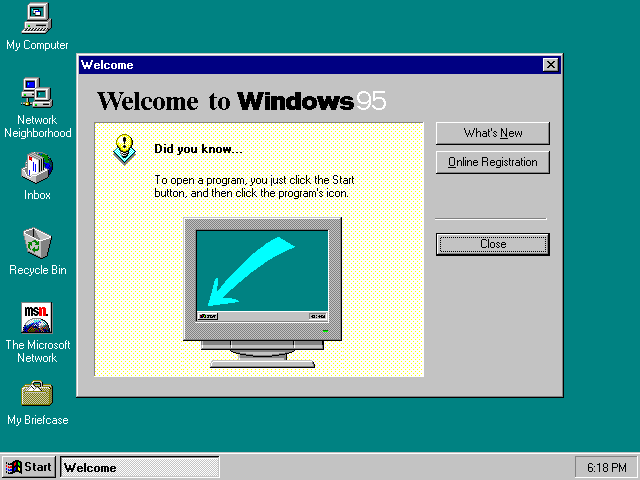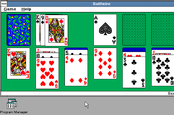This article is more than 1 year old
Start Me Up: 25 years ago this week, Windows 95 launched and, for a brief moment, Microsoft was almost cool
Then we saw Bill and Steve gyrating to the Rolling Stones on stage…
Comment Twenty-five years ago on Monday arguably the most consequential event in modern computing history happened: the release of Windows 95. Let’s take a quick trip back in time.
Bill Clinton was US president and the World-Wide-Web-era of the internet was in its infancy; there was war in Bosnia; Oasis and Blur were locked in a fierce battle of the bands in the UK; TV comedy Seinfeld was unstoppable; and newcomer Friends had just finished its somewhat disappointing first season.
Computers were very much with us, though less than a quarter of households in America, for one, had a PC. Computers were mostly for the tech savvy and for nerds, or for work; at home, most folks considered the machines clunky to use and turned to TV, magazines, and fresh air.
But something was bubbling: the web turned computers into worm holes into a growing galaxy of information; word processing and spreadsheets were increasingly a norm; and amid the arrival of the first Sony PlayStation, there was a renewed surge of interest in home video gaming. The time was right for an overhauled mass-market consumer-level operating system.
Microsoft knew its moment had come. It had shifted Windows from 16-bit to 32-bit – at least at the kernel-level with support for 32-bit applications – and rejigged its code to support preemptive multitasking and long filenames, optionally offered built-in TCP/IP networking, and included other bits and bytes to smooth the ride for users.

Welcome to Windows 95. Image credit: Microsoft
In a move that cemented its place in computing history and made Bill Gates the richest man on Earth, Microsoft stopped stealing its ideas from the likes of Xerox PARC and Apple – and came up with a few of its own, forming Windows 95. And the biggest was the Start button which, even a quarter of a century later still exists albeit after various redesigns and rethinks.
The Start button has informed pretty much everyone’s understanding of how to interact with a Microsoft OS and Redmond, to its credit, knew it had something good on its hands. (And yeah, we know RISC OS, at least, had an icon bar before Windows 95 got its task bar; it didn't quite have a Start button, though, unless you installed one of many third-party apps.)
There were a range of other Windows 95 features that were eventually added, most of which carry through to today – and were not all exclusive to Windows: right-clicked context menus; the desktop as a folder and the My Computer icon; shortcuts; the recycle bin; a better way to get at files and settings through Windows Explorer and Device Manager; and the much-touted Plug and Play which tried to automate the process of installing drivers and getting things like printers working without much fuss. And let’s not forget FreeCell.
Smithers, have the Rolling Stones killed
In a moment of marketing clarity, Microsoft went all-in on the Start button. It licensed The Rolling Stones’ hit single Start Me Up for a staggering $10m (give or take) and the song accompanied countless promotions in the lead-up to the big day.
Microsoft even went to the extraordinary length of commissioning the “world’s first cyber sitcom” starring soon-to-be megastars Jennifer Aniston and Matthew Perry, who were invited into Bill Gates’ office (but not really) to experience Windows 95 for themselves: the 30-minute extravaganza (yes, 30 minutes) is not good but then it’s not excruciating either.
The launch of Windows 95 was huge, and for what felt like the first time in ages, computery news transcended the IT press and became a mainstream event. Long before Apple loyalists slept on sidewalks to buy the latest iPhone, nerds stayed up all night on August 24, 1995 in order to be first to get into a store and grab their copy of Windows 95 before anyone else.
Photos of crammed computer stores and triumphant purchasers hit the papers when normal people woke up several hours later. Microsoft used them extensively in its follow-up, massive, advertising campaign.
Those with CD-ROM drives gleefully inserted the shiny discs and embarked on the modern computing era; those still relying on 3.5-inch “floppy” disks got a hefty stack on them to run through, correctly and in order, before they could hear the new startup jingle composed by Brian Eno himself.
And what was really great was that Windows 95 would do all the hard work behind the scenes: install it and it would take all the Windows 3.1 file systems and settings and automatically feed them into the new system. For many, it just worked. And the end result was worth it.
It felt like the future and Microsoft was very nearly cool.
And then Bill Gates and Steve Ballmer, and all the spectacularly uncoordinated engineers that had designed Windows 95, took to a stage at a big live event, dancing to the Rolling Stones Start Me Up – and reality suddenly reimposed itself:
Start Me Up? More like turn me off
Plug and Play quickly became known as “Plug and Pray” as its wildly inconsistent approach meant it sometimes worked wonderfully and sometimes just didn’t. Due to compromises made in the operating system's 16-slash-32-bit design and memory protection choices, some applications had a tendency to crash the whole system if not themselves, and windows in the new Windows would stagger themselves all the way across the screen. USB support came in 1997 – a year after the first spec was released. And there were countless other small problems that somewhat undercut the excitement and hype.
And the truth was, despite all its advances and innovations, it wasn’t until Windows 98 that various problems were smoothed out and a world-class, for the time, consumer-grade operating system was born. At that point, Microsoft simply dominated everything.
And then it abused its position to such a ludicrous degree that the US government and Europe were forced to drag Redmond through antitrust investigations: something that free-market-loving America hates doing. That famous trial in the States only came after a dropped FTC probe and dozens of lawsuits that managed to build up a massive pile of evidence, and with Microsoft simply refusing to stop screwing everyone.
Back to true form
Internet Explorer, initially an optional add-on, was later offered for free or bundled with every copy of Windows, triggering the first browser war. And Microsoft used its market-dominant OS to ruthlessly steamroller those who stood in its way. The technical and design jump that Windows 95 represented became a double-edge sword for the world; its success gave Microsoft the power to pander to its worst instincts.
And that’s not forgetting that almost immediately after Windows 95 was released, Microsoft reverted to type: stealing rather than innovating; milking rather than continuing to push the boundaries; gobbling up small companies and kludging them into Windows; and so on.
Then we had the fiasco that was Windows ME before the software goliath found its feet in the consumer space again with Windows XP – built upon its actual proper operating system foundation, the Windows NT family – before producing the questionable Vista and Windows 8.
It wasn’t until Google arrived and Apple found a new lease of life that Microsoft was pushed off its greed-and-laziness default and driven back toward innovation. Whatever you say about Microsoft, you can’t deny the extraordinary impact Windows has had on virtually every person on the planet.
And it all really began or at least kicked into high gear, for better or worse, with the launch of Windows 95, a quarter of a century ago today. ®

 Biting the hand that feeds IT
Biting the hand that feeds IT